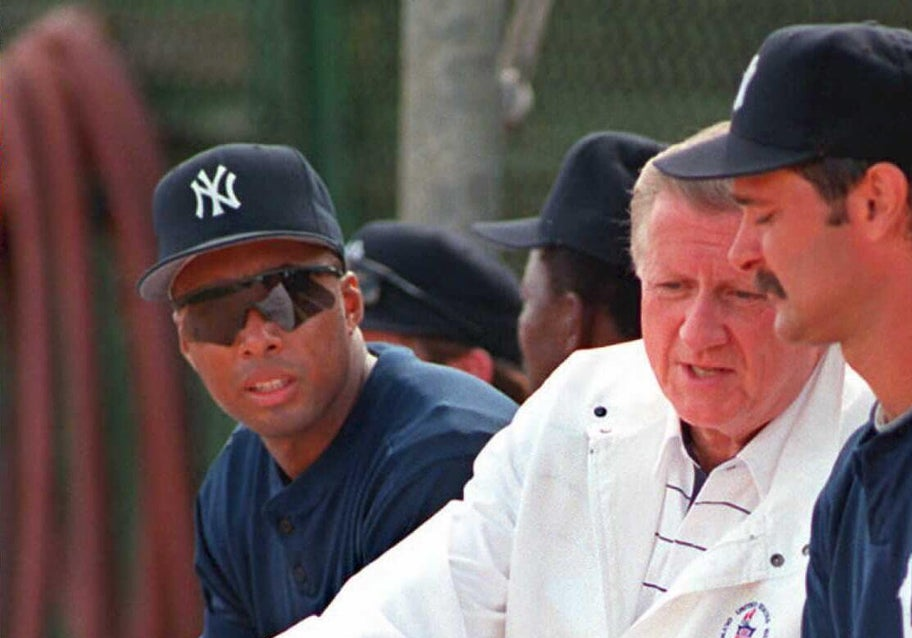MESA, Ariz. – The texts started coming as the sun came up in the Cactus League. Hey, Tony Clark, now you can make a comeback with the Yankees!
Clark, the executive director of the Players Association and a former Yankees first baseman, personifies a celebrated ritual for ex-Yankees: shed the pinstripes, grow a beard. Clark’s is meticulously manicured, like a hedge at a European mansion. But is it sufficiently “well-groomed” to fit Hal Steinbrenner’s revised facial hair policy in the Bronx?
“I do my best to take care of what’s growing out of my face that’s no longer growing out of my head,” Clark said with a laugh, after a clubhouse visit with the A’s on his annual spring training rounds. “Playing there, at that time, I still had hair, so I figured I’d grow that out and clean (my face) up. I looked like I was 12 years old again.”
That was part of the fun of the Yankees’ longstanding grooming rules. How would the bearded guy look without the beard? The comic caveman Johnny Damon? The rowdy rebel Jason Giambi? They grabbed a razor as part of the deal, a small sacrifice for Steinbrenner riches.

“I think we need to keep it how it was,” Damon said on Instagram Friday, adding, “The Yankees are a tradition. Let’s keep it.”
Of course, Damon played under Hal’s father, George Steinbrenner, whose reign as owner was a 37-year quest for an impossible level of control. All the fury and firing couldn’t guarantee success, but at least he could mandate that his players look like military school students, as he once was.
Conforming to the Steinbrenner ideal was so important that the team fined and benched Don Mattingly for refusing a haircut in 1991. It was a funny thing to prioritize, such an antiquated and stodgy concept to uphold. But it was part of being a Yankee, and over time it became almost charming, one of those stylistic quirks that differentiated the Yankees from everyone else.
To opponents — even the hairiest, like Dallas Braden — it symbolized something more than style.
“I think my answer might surprise you,” said Braden, a former A’s pitcher and now a bearded broadcaster. “I value and respect groups or individuals that stand for something they believe in. And they believed, and have believed for a very long time, that this was how they were going to operate.
“And that’s an initial separator when it comes to the psyche of being a competitor, if you’re able to sort of create that value by saying: ‘You’re in a special group. You’re a Yankee, and that comes with history, that comes with class, that comes with how we carry ourselves. We just have expectations that are obviously, all around, just a little higher than everybody else.’ So it means a little more, to them anyway, to be a part of that.
“And if that’s the culture that they wanted to create and have thrived in for a long time, so be it. But I think now you just understand our society is at a place where people don’t necessarily value that to the extent that they may have been valued in the past — the idea of being part of something, the idea of being a Yankee.”
The Yankees maintain some traditions. They don’t put players’ names on the backs of their jerseys. They still play “God Bless America” at the seventh-inning stretch. They haven’t sold the naming rights to Yankee Stadium. They don’t have a “City Connect” uniform.
But they stained the vaunted pinstripes with a cheesy advertising patch that debuted in 2023. They still hold Old-Timer’s Day, but stopped playing the Old-Timer’s Game. And last winter, they lost a bidding war to the Mets.

You can’t fault the Yankees there; they offered Juan Soto a 16-year, $760 million contract, then smartly pivoted to a sampler platter of Max Fried, Devin Williams, Cody Bellinger and Paul Goldschmidt. The path to the American League pennant runs through the Bronx.
Yes, the Yankees lost the World Series to the Los Angeles Dodgers last fall, looking sloppy in a humbling clincher at home. When the same thing happened in 1981, George Steinbrenner issued a public apology, cast aside Reggie Jackson and fired manager Bob Lemon two weeks into the next season.
This time, Hal Steinbrenner gave manager Aaron Boone a contract extension while Brian Cashman enters his 28th season as general manager.
It is wise to recognize and reward sound leaders. Fans might complain, but they seem to enjoy the product: Last year was the Yankees’ fifth in a row as the AL attendance leader (in full-capacity seasons), and they haven’t been lower than second since 2000.
When it comes to the George Steinbrenner era, it helps to remember a Billy Joel lyric: “The good old days weren’t always good.” The Boss burned to win — which is more than some current owners can say — but his dark side plunged the team into chaos by 1990, part of a six-year period (1987 to 1992) when the Yankees were outdrawn both by their neighbors, the Mets, and small-market rivals like the Minnesota Twins.
(For the sordid details of just how bad things got, watch the Peacock documentary “Bronx Zoo ’90,” or Google the name Howie Spira. It’s worse than you think.)
Hal Steinbrenner understands this more intimately than anyone. He keeps a high payroll but otherwise runs the Yankees as the deliberate opposite of his father. George was impulsive and rash; Hal is cautious and measured. George thrived on a culture of chaos; Hal values stability. George craved attention; Hal has little use for the spotlight.
Hal has kept the best professional attribute of his father — the willingness to reinvest in the roster — without all the bluster. Yankees fans should be grateful for that. But some of the old man’s ideas lent an intangible aura to the brand, affirming a self-image that, win or lose, the Yankees should stand apart from the rest. The silly grooming policy underscored that message.
It was harmless enough, and it will be missed. But as long as we’re changing stuff, maybe the Yankees can really loosen up and have some fun.
That’s right, folks. It’s time for a mascot.
(Top photo of Bernie Williams, George Steinbrenner and Don Mattingly in 1995: Doug Collier / AFP via Getty Images)



